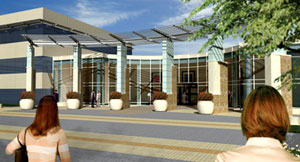TEXAS SPOTLIGHT
Technology Fund Targets
High-Tech Commercialization
High-Tech Commercialization
States don't win Site Selection's Governor's Cup two years in a row – as did Texas in 2005 and 2006 – on the strength of just one region.
 |
| Koll Development Co. is in the midst of redeveloping the 1.2- million- sq.- ft. (111,500- sq.- m.) former EDS campus in Plano. The 107- acre (43- hectare) site north of Dallas is now known as The Campus at Legacy and is in one of the two top submarkets in the Dallas- Fort Worth Metroplex. Access to domestic and international air transportation is behind many companies' decisions to locate in these markets; the Legacy development is about 25 minutes to DFW airport and Love Field. |
 |
More recently, Molecular Imprints, Inc. (MII), a spin- off company from the University of Texas in Austin, announced it will receive a $3- million project grant from the Texas Emerging Technology Fund (TETF) to help accelerate commercialization of its nano- lithography equipment for the semiconductor integrated circuit industry. "The additional resources provided will help our company establish Texas as the world focal point for nano- scale manufacturing," noted Mark Melliar- Smith, MII's CEO, when the grant was announced in late May.
MII applied for the grant through the Central Texas Regional Center of Innovation and Commercialization (CenTex RCIC). The CenTex RCIC is a virtual center that operates out of the Greater Austin Chamber of Commerce and serves as a catalyst for emerging technology research, development, commercialization, and start- up incubation. In an effort to keep Texas globally competitive, the CenTex RCIC focuses on integrating technology development and commercialization. The center also works closely with the Chamber's AusTech Alliance, a group of technology businesses and organizations working together to strengthen and grow the technology sector in Central Texas.
Other recipients of TETF grants are:
• CardioSpectra, Inc., of San Antonio, which was awarded $1.35 million for the commercialization of its Optical Coherence Tomography Catheter, which allows doctors to better predict the likelihood a patient will suffer a heart attack based on vascular plaque;
• Xilas Medical, Inc., also of San Antonio, which got $1 million from the fund for the commercialization of three devices used in the early detection neuropathies, foot stress and inflammation that often lead to diabetic ulcer and amputation; and
• CorInnova, Inc., of College Station, which was awarded $500,000 for the commercialization of its Heart Therapy Device that reduces the instances of congestive heart failure in patients who have suffered a severe heart attack.
States are increasingly aggressive in their support of such start- ups, and Texas is no exception. "Over the next decade, emerging technologies will generate $3 trillion in revenue worldwide," observed Gov. Rick Perry at the time the grants were announced in May 2006. "The question is, where will those investments be made, and who will reap the benefits? The TETF helps ensure that Texas has the competitive edge to provide greater opportunity, prosperity and a brighter future for all of our people."

